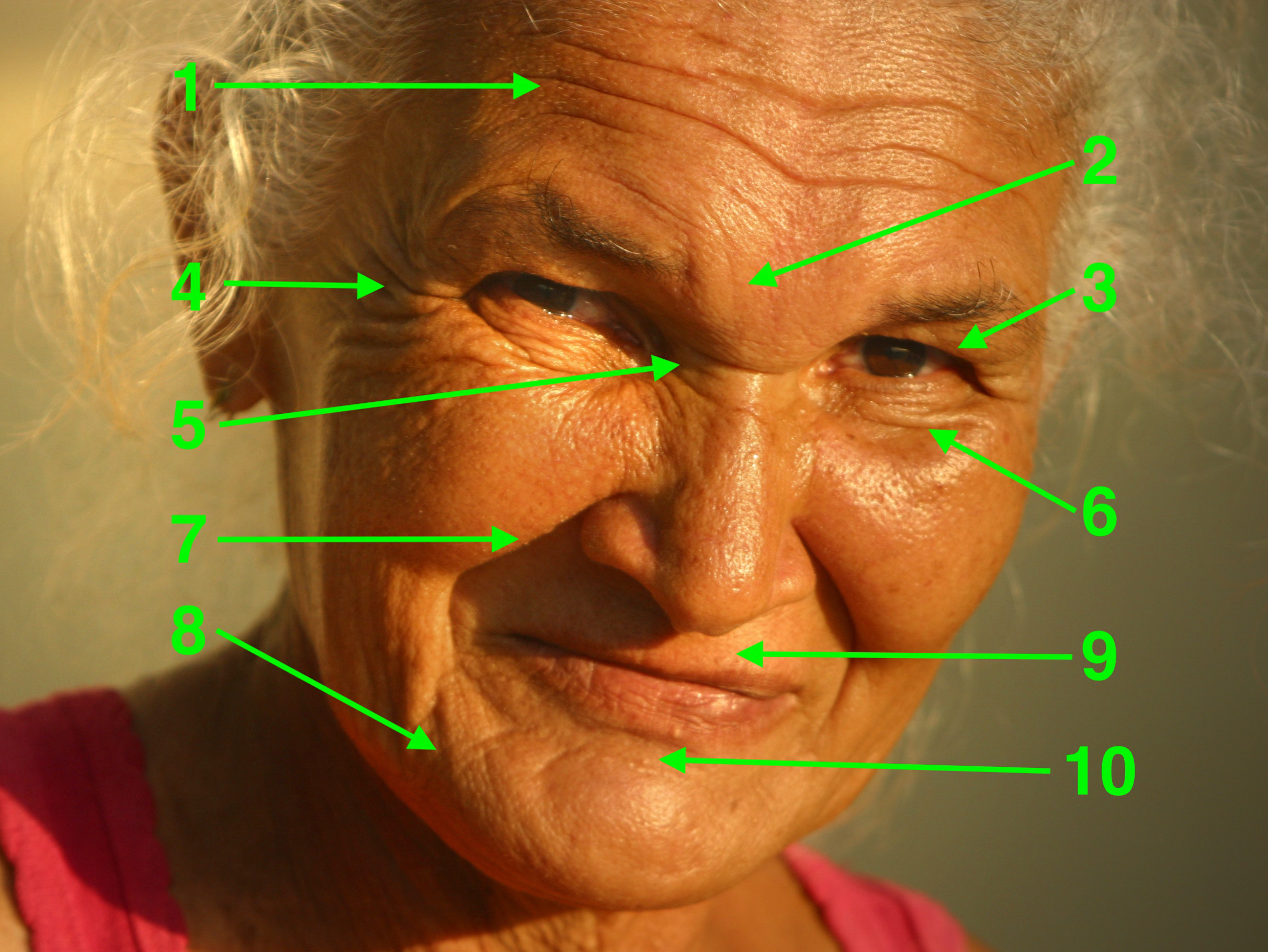cs766-computer-vision-project
Age Estimation from Rhytides
Group Members: Tom Reitz (treitz@wisc) and Zach Baklund (baklund@wisc)
Introduction
Age estimation from face images is an active research area [1], with applications ranging from facial aging simulation to security, surveillance, and biometrics.
Various aspects of human faces change as we age. In children, head shape changes rapidly as the skull and jaw develop. In adults, head and facial hair color and density change, skin blemishes may appear, and rhytides (facial wrinkles) often develop as a result of the breakdown of collagen in the skin.
Age estimation can be difficult and imprecise, as environmental and genetic factors affect aging rate and make perceived age vary greatly among individuals. Many studies use distances between facial landmarks for age estimation. [2] used Sobel edge magnitude to extract wrinkle density and depth from face images for age estimation, but this work did not differentiate types of wrinkles in different parts of the face. Other recent work has focused on global methods including deep learning on face image sets.
Problem Importance and Interest
Age estimation from face images is an interesting research area which has been explored in prior work (such as [3], [4], [5], and [6]), but estimation accuracy from these studies remains low – around 80% to 86%, no better than human accuracy [7].
Facial detection and facial recognition systems have improved dramatically in recent years by using deep neural networks, but such approaches provide little insight into the underlyfing features being used to detect and recognize faces in images. Moreover, they typically do not provide age estimates.
We believe that rhytides are a logical and easily-derived feature important to age estimation. Specifically, we are interested in this problem for several reasons: firstly, the problem is of general interest to the public; secondly, our proposed work is a new direction in an existing field which means we can easily measure improvement against prior methods; finally, even if our method does not result in better age estimation accuracy, we can still present qualitative analysis and examples, such as distribution and intensity of different wrinkle types by age, gender, and race.
In this project, we focus on age estimation based on specific types of rhytides as they appear in different parts of faces:
-
Forehead lines
-
Glabellar frown lines
-
Upper eyelid hooding
-
Crow’s feet (outside corners of eyes)
-
Bunny lines (inside corners of eyes)
-
Bagging of lower lids
-
Nasolabial folds (laugh lines)
-
Marionette lines or jowls
-
Lip lines (vertical lines on upper and/or lower lip)
-
Mental crease (between chin and lower lip)

Proposed Work
We will use existing face detection software (OpenCV) to detect faces in an image, then we will use edge detection in specific regions of the face image to identify and quantify the prescence of the aforementioned types of rhytides. With this code, we will process existing datasets (such as [8], [9], or [10]) of age-labeled face images to study the distributions of each rhytide type by age and gender. We will train a simple ML model to predict age from rhytide measurements, and finally we will compose all of these steps into an age-prediction pipeline.
Challenges
Image quality issues such as poor lighting or low resolution may make detecting and quantifying rhytides more difficult. We will mitigate this by studying only high-quality face images.
Facial expressions also change the appearance of rhytides – a smiling, angry, or surprised face may show different wrinkles than a neutral one. We may be able to use [11] to classify emotion in a face image and then weight the rhytide intensities differently for each emotion.
Finally, other factors may interfere with rhytide detection, such as makeup or facial hair obscuring some rhytides. This issue has no simple solution.
Timeline
-
By March 10, we will have written code that detects faces in an image.
-
By March 24 (in time for the Midterm Report), we will have written code that segments areas of a face image in which to search for each rhytide type, and does edge detection within each area to quantify the intensity of each rhytide type in the face. We will show the results of this code for several example face images in our report.
-
By April 9, we will have processed at least one large face image dataset using our rhytide detection code, and we will analyze the results to determine the distribution of different rhytide types by age and gender.
-
By April 23 (in time for the Final Presentation), we will present our findings from above and we will have train an ML model to predict age based on rhytide intensities. We plan to demonstrate the model’s predictions on sample face images in our presentation.
Evaluating Performance
We will train our machine learning model using the standard 80/20% training/testing split. We will then evaluate performance of our model using mean absolute error (MAE) between predicted age versus ground-truth age labels in face image datasets. Since MAE is a standard error measure in other age estimation studies, we will be able to compare our accuracy against other methods.
For age group classification, we will report accuracy as correct prediction percentage (in line with prior studies).
We hope to show that, especially in adults, focusing on specific types of wrinkles produces robust age estimates.